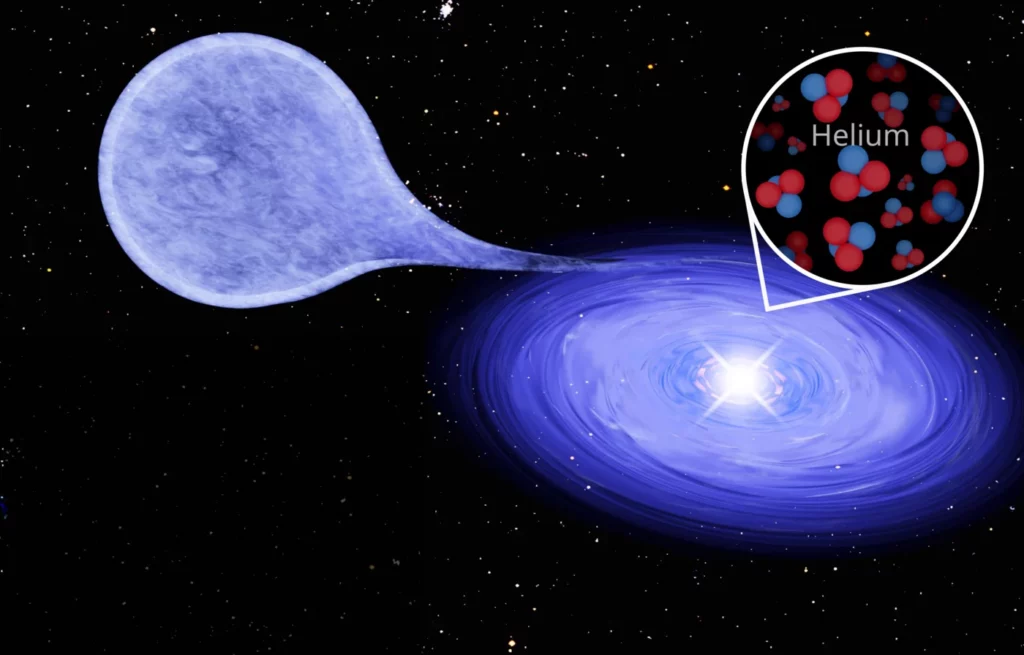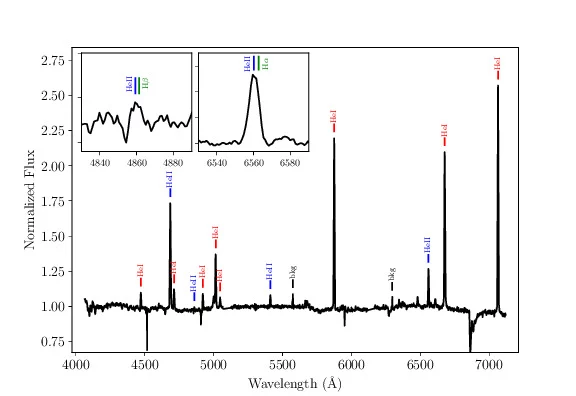
22 Mar SALT aids in the discovery of a unique white dwarf system that may help explain supernova origins
Researchers from the Max Planck Institute for Extraterrestrial Physics, in collaboration with South African astronomers, have discovered a rare white dwarf binary star system, located in the Large Magellanic Cloud, that sheds new light on supernova explosions. The discovery of this system, named [HP99] 159, was made using the Southern African Large Telescope (SALT) and could help solve the mystery surrounding the circumstances under which white dwarfs explode. These results have just been published in the journal Nature.

Artist’s impression of a supersoft X-ray source: the accretion disk around a white dwarf star is made mainly of helium.
© schematics: F. Bodensteiner; background image: ESO
White dwarfs can only explode as supernovae when their mass exceeds a certain limit. One of the primary aims of this research was to understand the process by which the mass of a white dwarf can grow to this point, known as the Chandrasekhar limit. The team found that [HP99] 159, unlike other known Super Soft Sources (SSS), was overflowing and burning helium, not hydrogen, which had not been observed before in such detail.
Using SALT’s two spectrographs, the team was able to determine that the optical spectra of the system were entirely consistent with helium accretion. The measured luminosity suggests that the mass of the white dwarf is growing more slowly than previously thought possible, which could potentially help understand the number of supernovae caused by exploding white dwarfs.
“This demonstrated the uniqueness of this object, but also the capability of SALT’s two spectrographs allowing for the required detailed follow-up optical observations, confirming the nature of the source ”, said Dr Itumeleng Monageng.

Low-resolution optical spectrum of [HP99] 159, taken with the SALT/RSS spectrograph, with labels for the main emission lines, which are all due to helium. (The two ‘bkg’ labels are residuals of removing sky lines). The insets demonstrate that at two wavelengths, where He- and H-lines are close together, the signal results from He II and not hydrogen.
© MPE
The unique properties of [HP99] 159 suggest that it could end up in a subclass of SN Ia, known as SN Iax, which have weaker explosions and therefore less helium is blown away. The team hopes to find dozens of similar sources in the two Magellanic Clouds with the eROSITA telescope, which could help further constrain the conditions for SN Ia progenitors.
“This is another excellent example of the productive collaborations between our team and the German eROSITA team in discovering and studying new and interesting transient phenomena,” said Prof David Buckley at the South African Astronomical Observatory (SAAO), who leads the SALT transient programme for which the optical observations were obtained, and with, Dr Monageng, is one of the paper’s co-authors.
Contact:
David Buckley: DAH.Buckley@saao.nrf.ac.za
Daniel Cunnama: d.cunnama@saao.nrf.ac.za
Original Press Release: https://www.mpe.mpg.de/7938487/news20230322
Paper: https://www.nature.com/articles/s41586-023-05714-4
Images and Captions
Fig 1: Artist’s impression of a supersoft X-ray source: the accretion disk around a white dwarf star is made mainly of helium.
© schematics: F. Bodensteiner; background image: ESO
Fig. 2 | Low-resolution optical spectrum of [HP99] 159, taken with the SALT/RSS spectrograph, with labels for the main emission lines, which are all due to helium. (The two ‘bkg’ labels are residuals of removing sky lines). The insets demonstrate that at two wavelengths, where He- and H-lines are close together, the signal results from He II and not hydrogen.
